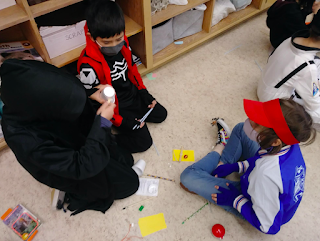Chemical Changes!
Science: I can explore household substances; I can use the scientific method to answer a question: I can design a fair test.
In class, we have been learning about Chemistry and Matter. This week, we have been learning about physical and chemical changes. A Chemical Change is when there's a change that creates something new and a Physical Change is when its appearance changes but it's still the same substance.
Five clues that a chemical change has happened are:
- Bubbles form
- Heat is released
- Light is produced
- There is a colour change
- A smell is produced
An example of a Physical Change would be changing States of Matter:
- An ice cube melting to water
Yesterday, we put baking soda in a balloon and mixed it with vinegar to see what would happen. The balloons inflated. It was fun to watch them. When you mix baking soda and vinegar, it creates carbon dioxide (CO2) gas. They expanded because of the increase in carbon dioxide gas. We know the molecules, when they turn into a gas, try to spread out and take up as much space as they can. They have a lot of energy.
We heard it fizz a lot and it made cute bubbling noises like a cartoon. It was super fun to be able to feel the pressure of the CO2 gas pressing against the sides of the balloon.
We had three balloons because each one had a different amount of baking soda (1/2 cup, 1/3 cup, and 1/4 cup). We were testing to see which balloon would inflate the fastest and Which one inflated the most. We tested twice to see if something reacted differently or if there was a fluke. The more trials we have, the more accuracy we have.
In conclusion, we discovered that the 1/2 cup produced the biggest and fastest reaction.



